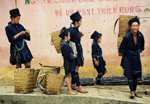|
Editor's
note: Welcome to the Global Health page. The purpose of this feature is
to raise awareness of global health issues with an academic spirit to
help improve the quality of care provided to patients. E-mail
globalhealthnews@musc.edu.
by Van Tran
First year, College of Graduate Studies
Although the Vietnam War ended more than 30 years ago, many Westerners
still visualize the country through a dated lens. As the most severe
war in Vietnam, casualties included 3 to 4 million Vietnamese, 1.5 to 2
million Laotians and Cambodians, and 58,159 U.S. soldiers. Weak health
care growth was another result of the war, leaving Vietnam medically
and technologically behind for decades.
 The
Vietnamese are recognized for being short and thin, with a short life
expectancy and a high rate of infant mortality. Following the war, the
Vietnamese population expanded rapidly due to traditional habits. Most
families tried to produce at least one son in order to maintain the
family tree, and having more children was beneficial for labor and
income purposes. Unfortunately, this increased population suffered from
a destroyed country, ruined economy, extremely poor infrastructure,
pollution, and lack of any health care system. Many suffered from
extreme malnutrition, weak immunization systems and weakened bodies. The
Vietnamese are recognized for being short and thin, with a short life
expectancy and a high rate of infant mortality. Following the war, the
Vietnamese population expanded rapidly due to traditional habits. Most
families tried to produce at least one son in order to maintain the
family tree, and having more children was beneficial for labor and
income purposes. Unfortunately, this increased population suffered from
a destroyed country, ruined economy, extremely poor infrastructure,
pollution, and lack of any health care system. Many suffered from
extreme malnutrition, weak immunization systems and weakened bodies.
 Up
until the late 1980s, almost half of the population had no access to
clean water. A deficiency in clean water supply and sewage systems
promoted such infectious diseases as malaria, cholera, dengue fever and
typhoid. Up
until the late 1980s, almost half of the population had no access to
clean water. A deficiency in clean water supply and sewage systems
promoted such infectious diseases as malaria, cholera, dengue fever and
typhoid.
Inadequate funding led to a shortage of nurses, doctors and hospital
services. According to the World Bank, Vietnam had roughly 250,000
hospital beds or 14.8 beds per 10,000 people by the end of the 20th
century. Health insurance was provided by the government for students,
government employees and retired people; others had the option of
buying or not buying insurance. Most couldn’t afford the insurance and
many private clinics do not accept any type of insurance to this day.
The 21st century economic boom marked an improvement in the health care
system when private clinics and health centers opened in urban areas,
and people began to earn enough money to cover their health costs. The
upper class is seen by private hospitals/doctors, where they get better
services; while the lower class visits public clinics.
 A
simple comparison: a regular screening service at the women’s health
center in a public hospital may cost around 15,000 Vietnam Dong (about
1 U.S. dollar,) but can range from 50,000 to 100,000 Vietnam Dong at a
private hospital in Hanoi, the capital of Vietnam, depending mostly on
the reputation of the doctor. Vietnamese citizens requiring emergency
care often bribe doctors and nurses for efficient service. A
simple comparison: a regular screening service at the women’s health
center in a public hospital may cost around 15,000 Vietnam Dong (about
1 U.S. dollar,) but can range from 50,000 to 100,000 Vietnam Dong at a
private hospital in Hanoi, the capital of Vietnam, depending mostly on
the reputation of the doctor. Vietnamese citizens requiring emergency
care often bribe doctors and nurses for efficient service.
A huge demand in health service from a population of 86 million people
has made it extremely difficult to improve these services. Most
hospitals are outdated; they lack sufficient beds and have old
equipment, especially in small towns and rural areas. Those who travel
to bigger cities from rural areas often stay there, which results in
the poorer regions lacking well-educated professionals.
Inadequate funding also has contributed to a poor education system and
resulted in a highly illiterate population. According to the United
Educational, Scientific and Cultural Organization institute, the
current adult literacy rate in Vietnam is 92.5 percent.
Vietnam is still recovering from a war that happened more than 30 years
ago, and health care remains a prevalent concern for the Vietnamese
community.
Vietnam population facts
- Population
posted at 85,789,573.000 by April 1, 2009 (13th highest worldwide with
the territory equivalent to half of Texas, where population is around
25 million)
- Growing rate 947,000,000 from 1999-2009
- Population estimates at 117 million by 2050
- Handicap estimates at 7 percent of population
- Life expectancy 60.2 (world average 70.2)
Clinician’s corner
A
5-year-old boy presents to the emergency department a few days after
returning from a trip to Vietnam via ambulance after suffering a
prolonged seizure. He has had two to three days of fever, headache,
vomiting, and fatigue, and now also has neck stiffness. His parents
have noted that his speech has been slurred and he has had some unusual
behaviors. On physical exam the child has lethargy, meningeal signs,
and a left hemiparesis. He has no rash, but you notice several
scattered papules on his extremities that the parents confirm are
healing mosquito bites. The most likely diagnosis for this child is:
A) Typhoid fever
B) Japanese encephalitis
C)
Malaria
D) Lassa fever
Answer:
“B” This child most likely has Japanese encephalitis (JE), a
mosquito-borne flaviviral infection. JE is the leading cause of
childhood viral encephalitis in Asia. Most cases are asymptomatic but
of those that come to medical attention, meningitis or encephalitis is
usually present. Symptomatic cases often start as a flu-like illness
that can worsen and cause high fever, neck stiffness, brain damage,
coma, or death. Younger children are more likely to die and have
neurological complications and sequelae. An inactivated JE vaccine was
recently approved for use in the U.S. for persons 17 years and older
who plan to travel to an endemic area.
Announcements
Charleston History Walking Tour
Monday, Oct. 3, 10 a.m. - 1 p.m.
Meet at Riverfront Park Downtown
Global and Tropical Medicine Interest Group talk, “Challenges to the
Elimination of Childhood Cataract Blindness in the Developing World.”
Oct. 5 at 6 p.m., Storm Eye Institute Auditorium (8th floor)
International Halloween Lunch
Wednesday, Oct. 28, 12 - 1 p.m.
Harper Student Center Auditorium
Visit http://www.musc.edu/international.
Friday, Sept. 25, 2009
|



 The
Vietnamese are recognized for being short and thin, with a short life
expectancy and a high rate of infant mortality. Following the war, the
Vietnamese population expanded rapidly due to traditional habits. Most
families tried to produce at least one son in order to maintain the
family tree, and having more children was beneficial for labor and
income purposes. Unfortunately, this increased population suffered from
a destroyed country, ruined economy, extremely poor infrastructure,
pollution, and lack of any health care system. Many suffered from
extreme malnutrition, weak immunization systems and weakened bodies.
The
Vietnamese are recognized for being short and thin, with a short life
expectancy and a high rate of infant mortality. Following the war, the
Vietnamese population expanded rapidly due to traditional habits. Most
families tried to produce at least one son in order to maintain the
family tree, and having more children was beneficial for labor and
income purposes. Unfortunately, this increased population suffered from
a destroyed country, ruined economy, extremely poor infrastructure,
pollution, and lack of any health care system. Many suffered from
extreme malnutrition, weak immunization systems and weakened bodies.  Up
until the late 1980s, almost half of the population had no access to
clean water. A deficiency in clean water supply and sewage systems
promoted such infectious diseases as malaria, cholera, dengue fever and
typhoid.
Up
until the late 1980s, almost half of the population had no access to
clean water. A deficiency in clean water supply and sewage systems
promoted such infectious diseases as malaria, cholera, dengue fever and
typhoid.  A
simple comparison: a regular screening service at the women’s health
center in a public hospital may cost around 15,000 Vietnam Dong (about
1 U.S. dollar,) but can range from 50,000 to 100,000 Vietnam Dong at a
private hospital in Hanoi, the capital of Vietnam, depending mostly on
the reputation of the doctor. Vietnamese citizens requiring emergency
care often bribe doctors and nurses for efficient service.
A
simple comparison: a regular screening service at the women’s health
center in a public hospital may cost around 15,000 Vietnam Dong (about
1 U.S. dollar,) but can range from 50,000 to 100,000 Vietnam Dong at a
private hospital in Hanoi, the capital of Vietnam, depending mostly on
the reputation of the doctor. Vietnamese citizens requiring emergency
care often bribe doctors and nurses for efficient service.